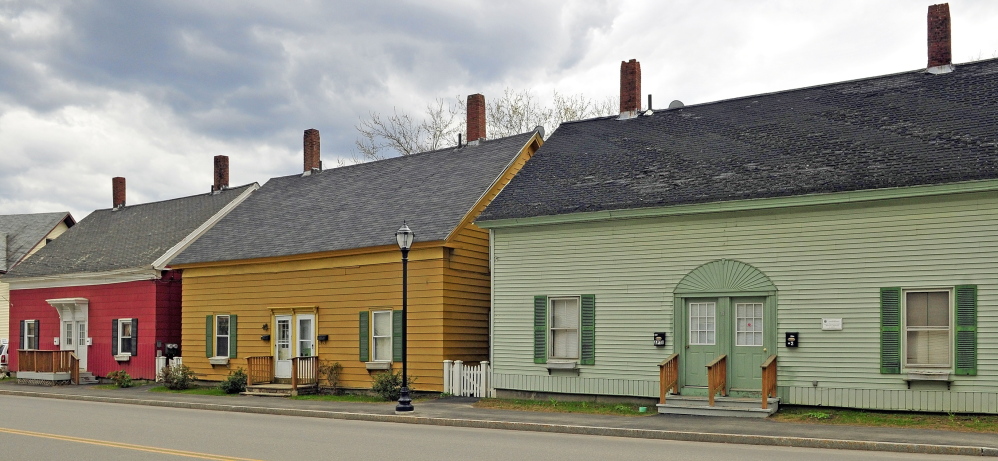AUGUSTA — Bond Street and its former mill-worker housing is officially historic.
The seven homes of the newly designated Bond Street Historic District were named last month to the National Register of Historic Places, the nation’s official list of cultural resources deemed worthy of preservation.
The neighborhood’s main claim to the designation is its connection to the former Edwards Manufacturing Co., which had a massive mill nearby next to the Kennebec River.
The Bond Street row houses were built by the mill’s owners to house workers, many of them Franco-Americans who toiled in the mill. The mill was destroyed by a massive fire in 1989. And the dam that powered the mill was removed from the Kennebec River in 1999.
Kirk Mohney, deputy state historic preservation officer and assistant director of the Maine Historic Preservation Commission, said the neighborhood is significant for “its association with Edwards Manufacturing Co., of which there is very little left from that major mill and industry” in Augusta. “As a group of buildings built by the company, for worker housing, they’re quite interesting both architecturally and from a social history standpoint.”
The buildings are primarily still rented out as housing in the neighborhood that had fallen into disrepair until efforts were made over the last several years to make improvements. Most of them were done without dramatically changing the appearance of the buildings.
“Most of the buildings on Bond Street, except for 25 Bond, have had their siding materials changed, but their chimneys, the patterns of their doors and windows are still the same,” Mohney said. “It’s still very clear they were constructed as housing for workers.”
Augusta landlord Larry Fleury, through his firm River City Realty, owns five of the seven properties on Bond Street, a short but busy street connecting Mount Vernon Avenue and Water Street. He lives in a Water Street home that looks directly across at Bond Street. He said he initiated the application process seeking the national historic designation after spending the last several years fixing up previously run-down properties he acquired there between 2004 and 2013.
“I was very frustrated back when that whole street was a disaster, there was trash all over the street and the buildings were broken down,” Fleury said. “I’ve had a lot of pride for that street. I lifted it out of the depths of despair. It’s a joy to have it fixed up now and to have great tenants there.”
In 2001 the nonprofit historic preservation advocacy organization Maine Preservation named the entire Bond Street neighborhood to its annual “Maine’s Most Endangered Historic Resources” list. The organization’s website now lists the neighborhood’s status as “saved” on a master list of every property it has listed as most endangered.
Fleury said his efforts to improve the properties on the street are largely responsible for the neighborhood making a comeback.
“I’ve single-handedly cleaned up that whole neighborhood. I’ve dumped gobs of money into that street,” Fleury said. “I look forward to continuing to make investments in that area, making it a quaint, historic and relevant neighborhood again.”
Fleury’s most recent Bond Street acquisition was 25 Bond St., which he bought from the city last year for $1. He was the only bidder for the property. Fleury said he has not yet started work on 25 Bond St., but he plans to rehabilitate it and rent it out as a single-family home. The city’s sale conditions require Fleury, or any other new owner, to preserve the structure. The mustard-yellow house has been boarded up for years and has paintings taking the place of its glass windows which depict curtained windows and in one window a man waving from inside.
Mohney said the national designation will not prevent building owners from making modifications to their buildings. He said the only situation in which owners could be required to consult with preservationists would be if they are doing work using federal funds or work that requires a federal permit or license.
Mohney said the designation makes rehabilitation work to income-producing properties in the district potentially eligible for federal and state historic preservation tax credits.
Fleury said he is not looking to use such credits on any work he has planned on his buildings on the street. However he said the “historic” designation could make it easier for him to get permits to do more extensive work on his buildings on the street, which are within the floodplain, than he might be able to do if they were not designated historic.
Mohney said the Maine Historic Preservation Commission has no plans to physically mark the district, such as with a plaque, but could provide building owners with certificates noting it is on the national registry if they request them.
He said there are a few scattered concentrations of historic worker housing around the state, mostly in former mill communities such as Augusta and Lewiston.
The homes, according to the application seeking national designation filed by the preservation commission, were built between 1875 and 1884 to house the textile mill workers and their families.
The historic district does not extend the entire length of the short road, as the buildings at the corners of Bond Street are not examples of company-built worker housing, the application notes.
Keith Edwards – 621-5647kedwards@centralmaine.comTwitter: @kedwardskj
Send questions/comments to the editors.








Success. Please wait for the page to reload. If the page does not reload within 5 seconds, please refresh the page.
Enter your email and password to access comments.
Hi, to comment on stories you must . This profile is in addition to your subscription and website login.
Already have a commenting profile? .
Invalid username/password.
Please check your email to confirm and complete your registration.
Only subscribers are eligible to post comments. Please subscribe or login first for digital access. Here’s why.
Use the form below to reset your password. When you've submitted your account email, we will send an email with a reset code.